MaryAnn Bernal's Blog, page 261
July 9, 2014
The Briton and the Dane featured on Booktrack

Read an excerpt accompanied to music
Note: The site can only be accessed using Chrome as your browser.
Enjoyed reading The Briton and the Dane with @Booktrack http://studio.booktrack.com/booktrack...

Published on July 09, 2014 05:52
History Trivia - Lady Jane Grey proclaimed queen of England
July 9
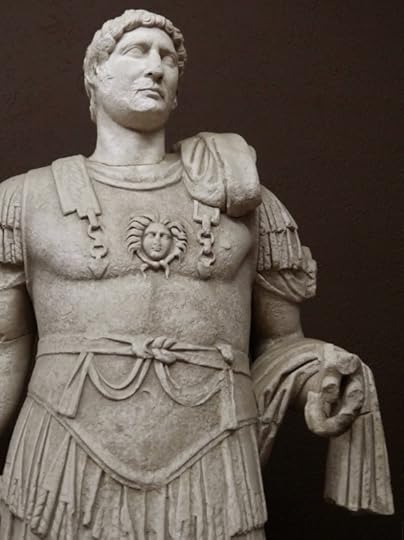
118 Hadrian, Rome's new emperor, made his entry into the city.

455 Avitus, the Roman military commander in Gaul, became Emperor of the West.

1357 Emperor Charles IV assisted in laying the foundation stone of Charles Bridge in Prague.

1540 King Henry VIII of England annulled his marriage to his fourth wife, Anne of Cleves.

1553 Lady Jane Grey was proclaimed queen of England in succession to Edward VI, who died three days earlier. Her reign lasted nine days since Mary Tudor (daughter of Henry VIII and Catherine of Aragon) claimed the right of succession.


118 Hadrian, Rome's new emperor, made his entry into the city.

455 Avitus, the Roman military commander in Gaul, became Emperor of the West.

1357 Emperor Charles IV assisted in laying the foundation stone of Charles Bridge in Prague.

1540 King Henry VIII of England annulled his marriage to his fourth wife, Anne of Cleves.

1553 Lady Jane Grey was proclaimed queen of England in succession to Edward VI, who died three days earlier. Her reign lasted nine days since Mary Tudor (daughter of Henry VIII and Catherine of Aragon) claimed the right of succession.

Published on July 09, 2014 05:51
July 8, 2014
Remains of Long-Lost Temple Discovered in Iraq
By Owen Jarus
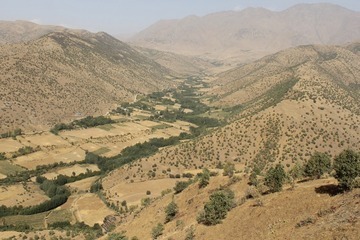
 Life-size human statues and the remains of an ancient temple dating back some 2,500 years have been discovered in the Kurdistan region of northern Iraq. The region's hilly environment, shown here.
Life-size human statues and the remains of an ancient temple dating back some 2,500 years have been discovered in the Kurdistan region of northern Iraq. The region's hilly environment, shown here.
Credit: Photo courtesy Dlshad Marf Zamua
Life-size human statues and column bases from a long-lost temple dedicated to a supreme god have been discovered in the Kurdistan region of northern Iraq.
The discoveries date back over 2,500 years to the Iron Age, a time period when several groups — such as the Urartians, Assyrians and Scythians — vied for supremacy over what is now northern Iraq.
"I didn't do excavation, just archaeological soundings —the villagers uncovered these materials accidentally," said Dlshad Marf Zamua, a doctoral student at Leiden University in the Netherlands, who began the fieldwork in 2005. The column bases were found in a single village while the other finds, including a bronze statuette of a wild goat, were found in a broad area south of where the borders of Iraq, Iran and Turkey intersect
For part of the Iron Age, this area was under control of the city of Musasir, also called Ardini, Marf Zamua said. Ancient inscriptions have referred to Musasir as a "holy city founded in bedrock" and "the city of the raven."
A lost ancient temple
"One of the best results of my fieldwork is the uncovered column bases of the long-lost temple of the city of Musasir, which was dedicated to the god Haldi," Marf Zamuatold Live Science in an email. Haldi was the supreme god of the kingdom of Urartu. His temple was so important that after the Assyrians looted it in 714 B.C., the Urartu king Rusa I was said to have ripped his crown off his head before killing himself.
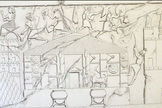 [image error]
[image error]
 A 19th-century drawing of an ancient relief that depicts the sacking of the temple of Haldi by the Assyrians.
A 19th-century drawing of an ancient relief that depicts the sacking of the temple of Haldi by the Assyrians.
Credit: Drawing by Eugène Flandin, in public domainView full size imageHe "threw himself on the ground, tore his clothes, and his arms hung limp. He ripped off his headband, pulled out his hair, pounded his chest with both hands, and threw himself flat on his face …" reads one ancient account (translation by Marc Van De Mieroop).
The location of the temple has long been a mystery, but with the discovery of the column bases, Marf Zamua thinks it can be narrowed down. [Photos: Ancient Temple Discovered in Turkey]
Additionally, Marf Zamua analyzed an ancient carving of Musasir, discovered in the 19th century at Khorsabad. The carving, he found, shows hillside houses with three windows on the second floor and a doorway on the ground floor. Such a design can still be seen today in some villages, the bottom floor being used as a stable and storage area, he noted.
Life-size statues
This long-lost temple is just the tip of the archaeological iceberg. During his work in Kurdistan, Marf Zamua also found several life-size human statues that are up to 7.5 feet (2.3 meters) tall. Made of limestone, basalt or sandstone, some of these statues are now partly broken.
They all show bearded males, some of whom "are holding a cup in their right hands, and they put their left hands on their bellies," said Marf Zamua. "One of them holds a hand ax. Another one put on a dagger."
Originally erected above burials, the statues have a "sad moment" posture, Marf Zamua said. Similar statues can be found from central Asia to eastern Europe. "It is art and ritual of nomads/pastorals, especially when they [buried] their chieftains," Marf Zamua said.
Mostof the newfound statues date to the seventh or sixth century B.C., after Musasir fell to the Assyrians, and during a time when the Scythians and Cimmerians were advancing through the Middle East.
Modern-day dangers and ancient treasures
Over the past few weeks, conflict in Iraq has been increasing as a group called the "Islamic State in Iraq and the Levant" (ISIS) has taken several cities and threatened to march on Baghdad. The Kurdistan area, including this archaeological site, is autonomous, and its militia has been able to prevent ISIS from entering it.
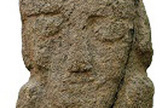 [image error]
[image error]
 Several life-sized human statues of bearded males, dating back to the seventh or sixth centuries B.C., have also been discovered in Kurdistan.
Several life-sized human statues of bearded males, dating back to the seventh or sixth centuries B.C., have also been discovered in Kurdistan.
Credit: Photo courtesy Dlshad Marf ZamuaView full size imageMarf Zamuasaid there are risks associated with living and working in the border area. Due to the conflicts of the past few decades, there are numerous unexploded land mines, one of which killed a young shepherd a month back, he said. Additionally the National Iraqi News Agency reports that Iranian artillery recently fired onto the Iraqi side of the border, and there have been past instances where planes from Turkey have launched attacks into Iraqi Kurdistan.
Despite these risks, there are also terrific archaeological finds to be made. In addition to the statues and column bases, Marf Zamuafound a bronze statuette of a wild goat about 3.3 inches (8.4 centimeters) long and 3.2 inches (8.3 cm) tall. Researchers are now trying to decipher a cuneiform inscription on the statuette.
Marf Zamua presented the discoveries recently in a presentation given at the International Congress on the Archaeology of the Ancient Near East, held at the University of Basel in Switzerland. In addition to his doctoral studies, Marf Zamua teaches at Salahaddin University in Erbil, which is the capital of Iraqi Kurdistan.
http://www.livescience.com/46674-remains-of-long-lost-temple-discovered-in-iraq.html

 Life-size human statues and the remains of an ancient temple dating back some 2,500 years have been discovered in the Kurdistan region of northern Iraq. The region's hilly environment, shown here.
Life-size human statues and the remains of an ancient temple dating back some 2,500 years have been discovered in the Kurdistan region of northern Iraq. The region's hilly environment, shown here.Credit: Photo courtesy Dlshad Marf Zamua
Life-size human statues and column bases from a long-lost temple dedicated to a supreme god have been discovered in the Kurdistan region of northern Iraq.
The discoveries date back over 2,500 years to the Iron Age, a time period when several groups — such as the Urartians, Assyrians and Scythians — vied for supremacy over what is now northern Iraq.
"I didn't do excavation, just archaeological soundings —the villagers uncovered these materials accidentally," said Dlshad Marf Zamua, a doctoral student at Leiden University in the Netherlands, who began the fieldwork in 2005. The column bases were found in a single village while the other finds, including a bronze statuette of a wild goat, were found in a broad area south of where the borders of Iraq, Iran and Turkey intersect
For part of the Iron Age, this area was under control of the city of Musasir, also called Ardini, Marf Zamua said. Ancient inscriptions have referred to Musasir as a "holy city founded in bedrock" and "the city of the raven."
A lost ancient temple
"One of the best results of my fieldwork is the uncovered column bases of the long-lost temple of the city of Musasir, which was dedicated to the god Haldi," Marf Zamuatold Live Science in an email. Haldi was the supreme god of the kingdom of Urartu. His temple was so important that after the Assyrians looted it in 714 B.C., the Urartu king Rusa I was said to have ripped his crown off his head before killing himself.
 [image error]
[image error]
 A 19th-century drawing of an ancient relief that depicts the sacking of the temple of Haldi by the Assyrians.
A 19th-century drawing of an ancient relief that depicts the sacking of the temple of Haldi by the Assyrians.Credit: Drawing by Eugène Flandin, in public domainView full size imageHe "threw himself on the ground, tore his clothes, and his arms hung limp. He ripped off his headband, pulled out his hair, pounded his chest with both hands, and threw himself flat on his face …" reads one ancient account (translation by Marc Van De Mieroop).
The location of the temple has long been a mystery, but with the discovery of the column bases, Marf Zamua thinks it can be narrowed down. [Photos: Ancient Temple Discovered in Turkey]
Additionally, Marf Zamua analyzed an ancient carving of Musasir, discovered in the 19th century at Khorsabad. The carving, he found, shows hillside houses with three windows on the second floor and a doorway on the ground floor. Such a design can still be seen today in some villages, the bottom floor being used as a stable and storage area, he noted.
Life-size statues
This long-lost temple is just the tip of the archaeological iceberg. During his work in Kurdistan, Marf Zamua also found several life-size human statues that are up to 7.5 feet (2.3 meters) tall. Made of limestone, basalt or sandstone, some of these statues are now partly broken.
They all show bearded males, some of whom "are holding a cup in their right hands, and they put their left hands on their bellies," said Marf Zamua. "One of them holds a hand ax. Another one put on a dagger."
Originally erected above burials, the statues have a "sad moment" posture, Marf Zamua said. Similar statues can be found from central Asia to eastern Europe. "It is art and ritual of nomads/pastorals, especially when they [buried] their chieftains," Marf Zamua said.
Mostof the newfound statues date to the seventh or sixth century B.C., after Musasir fell to the Assyrians, and during a time when the Scythians and Cimmerians were advancing through the Middle East.
Modern-day dangers and ancient treasures
Over the past few weeks, conflict in Iraq has been increasing as a group called the "Islamic State in Iraq and the Levant" (ISIS) has taken several cities and threatened to march on Baghdad. The Kurdistan area, including this archaeological site, is autonomous, and its militia has been able to prevent ISIS from entering it.
 [image error]
[image error]
 Several life-sized human statues of bearded males, dating back to the seventh or sixth centuries B.C., have also been discovered in Kurdistan.
Several life-sized human statues of bearded males, dating back to the seventh or sixth centuries B.C., have also been discovered in Kurdistan.Credit: Photo courtesy Dlshad Marf ZamuaView full size imageMarf Zamuasaid there are risks associated with living and working in the border area. Due to the conflicts of the past few decades, there are numerous unexploded land mines, one of which killed a young shepherd a month back, he said. Additionally the National Iraqi News Agency reports that Iranian artillery recently fired onto the Iraqi side of the border, and there have been past instances where planes from Turkey have launched attacks into Iraqi Kurdistan.
Despite these risks, there are also terrific archaeological finds to be made. In addition to the statues and column bases, Marf Zamuafound a bronze statuette of a wild goat about 3.3 inches (8.4 centimeters) long and 3.2 inches (8.3 cm) tall. Researchers are now trying to decipher a cuneiform inscription on the statuette.
Marf Zamua presented the discoveries recently in a presentation given at the International Congress on the Archaeology of the Ancient Near East, held at the University of Basel in Switzerland. In addition to his doctoral studies, Marf Zamua teaches at Salahaddin University in Erbil, which is the capital of Iraqi Kurdistan.
http://www.livescience.com/46674-remains-of-long-lost-temple-discovered-in-iraq.html

Published on July 08, 2014 13:02
Huge Trove of Dinosaur Footprints Discovered in Alaska
By Becky Oskin
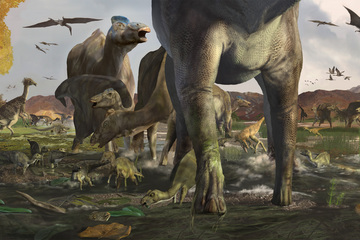
 Artist's conception of how the trace fossils were formed roughly 70 million years ago.
Artist's conception of how the trace fossils were formed roughly 70 million years ago.
Credit: Karen Carr/Perot Museum View full size image
A "world-class" dinosaur track site discovered in Alaska's Denali National Park shows that herds of duck-billed dinosaurs thrived under the midnight sun.
"We had mom, dad, big brother, big sister and little babies all running around together," said paleontologist Anthony Fiorillo, who is studying the dinosaur tracks. "As I like to tell the park, Denali was a family destination for millions of years, and now we've got the fossil evidence for it."
The discovery adds to Fiorillo's growing conviction that dinosaurs lived at polar latitudes year-round during the Late Cretaceous Period, about 70 million years ago
"Even back then the high latitudes were biologically productive and could support big herds of pretty big animals," said Fiorillo, curator of earth sciences at the Perot Museum of Nature and Science in Dallas.
Dino dance party
The dinosaur track site, near Cabin Peak in the park's northeast corner, has thousands of tracks from hadrosaurs, or duck-billed dinosaurs. Many of the deep tracks contain preserved skin and "nail" impressions from the plant-eating hadrosaurs.
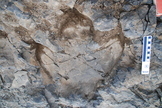 [image error]
[image error]
 A hadrosaur track from Denali National Park's amazing track site.
A hadrosaur track from Denali National Park's amazing track site.
Credit: Perot MuseumView full size image"This is definitely one of the great track sites of the world. We were so happy to find it," Fiorillo said.
Fiorillo and his collaborators also found traces from birds, clams, worms and bugs intermingled with the dinosaur tracks. Other dinosaur denizens who left behind footprints in Denali were ceratopsians, therizinosaurs and the flying reptiles called pterosaurs. Ferns and redwood cones complete the picture of a rich Cretaceous ecosystem.
The muddy ground is so rumpled by footprints that the researchers were hard-pressed to pull out tracks from individual hadrosaurs. Instead, they counted each print and grouped them by size. The results were published June 30 in the journal Geology.
There are four distinct size ranges, varying in length from 5 inches (about 12 centimeters) to 24 inches (about 60 cm). More than 80 percent of the tracks are from adults, and 13 percent are from young duckbills less than a year old. Just 3 percent are juvenile hadrosaurs. The researchers think the small number of juvenile prints suggest the young underwent a rapid growth spurt, spending only a short time as tiny, vulnerable dinosaurs (a theory also supported by studies of hadrosaur bones).
Duck-billed dinosaurs are the most common dinosaur fossils from the Late Cretaceous, with a wide range of species found on several continents. Call them the buffalo of the dinosaurs, grazing on the fern prairie and protecting their young in big herds.
Polar patrol
The evidence emerging from the Denali hadrosaur tracks show babies and juvenile dinosaurs living in Alaska during the summer. The juveniles probably couldn't endure a long migration, so the tracks suggest the dinosaurs spent their entire lives in the Arctic, rather than migrating from somewhere else, the researchers said.
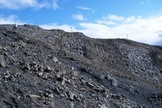 [image error]
[image error]
 Researchers document the full extent of the amazing dinosaur track site discovered in Denali National Park.
Researchers document the full extent of the amazing dinosaur track site discovered in Denali National Park.
Credit: Perot MuseumView full size imageSome researchers have speculated that dinosaurs migrated north to Alaska, perhaps even coming from Canada like huge caribou herds.
"If you take a great big herd of plains eaters, they have to move at some level, otherwise they strip out all the vegetation," Fiorillo said. "But there's a growing data set that suggests they didn't do the thousand and thousands of miles of migration that was originally considered."
During the Late Cretaceous, Alaska sat at about the same latitude as today, but it was a tectonic jigsaw puzzle that had yet to assemble into today's stunning topography. Mountain-fed rivers and streams flowed through Denali, but not the same mountains: the Alaska Range was just being born. Mount McKinley, now the tallest mountain in North America, didn't exist. The climate was warmer, similar to coastal Washington and Oregon, but sunlight still flipped between extremes, with lengthy summer days and long, dark winters. [In Images: How North America Grew as a Continent]
Despite the dark winters, scientists such as Fiorillo have uncovered scores of dinosaur fossils and tracks across Alaska in recent decades, from quarries near the North Slope oil fields down to Denali's spectacular mountains.
Preserving history
Fiorillo and colleagues from Texas, Japan and Alaska have been documenting the new Denali track site since 2011. Exhibits featuring copies of the Denali dinosaur fossils and hadrosaur footprints are on display in the park and at the Perot Museum in Texas.
The trampled ground sits at the top of a steep ridge and is exposed on a cliff face about 590 feet (180 meters) long. The tracks were made within a short time range, between 69 million to 72 million years ago, likely in a muddy river or stream bank during the height of summer, the researchers said. (The bugs and plants help pin down the time of year.)
The outcrop was revealed by a rockfall and could be destroyed by another landslide in the future, so researchers scanned the area with lidar (a high-resolution laser-scanning technique) to preserve the site forever.
"On one of the last nights, as work was coming to a close, I was lying in my tent and woke up to an earthquake in the park," Fiorillo said. "For the first time in my life, I wasn't worried about a big rock [hitting me]. I was worried about my track site sliding down the mountain."
http://www.livescience.com/46688-denali-huge-dinosaur-track-site.html


 Artist's conception of how the trace fossils were formed roughly 70 million years ago.
Artist's conception of how the trace fossils were formed roughly 70 million years ago.Credit: Karen Carr/Perot Museum View full size image
A "world-class" dinosaur track site discovered in Alaska's Denali National Park shows that herds of duck-billed dinosaurs thrived under the midnight sun.
"We had mom, dad, big brother, big sister and little babies all running around together," said paleontologist Anthony Fiorillo, who is studying the dinosaur tracks. "As I like to tell the park, Denali was a family destination for millions of years, and now we've got the fossil evidence for it."
The discovery adds to Fiorillo's growing conviction that dinosaurs lived at polar latitudes year-round during the Late Cretaceous Period, about 70 million years ago
"Even back then the high latitudes were biologically productive and could support big herds of pretty big animals," said Fiorillo, curator of earth sciences at the Perot Museum of Nature and Science in Dallas.
Dino dance party
The dinosaur track site, near Cabin Peak in the park's northeast corner, has thousands of tracks from hadrosaurs, or duck-billed dinosaurs. Many of the deep tracks contain preserved skin and "nail" impressions from the plant-eating hadrosaurs.
 [image error]
[image error]
 A hadrosaur track from Denali National Park's amazing track site.
A hadrosaur track from Denali National Park's amazing track site.Credit: Perot MuseumView full size image"This is definitely one of the great track sites of the world. We were so happy to find it," Fiorillo said.
Fiorillo and his collaborators also found traces from birds, clams, worms and bugs intermingled with the dinosaur tracks. Other dinosaur denizens who left behind footprints in Denali were ceratopsians, therizinosaurs and the flying reptiles called pterosaurs. Ferns and redwood cones complete the picture of a rich Cretaceous ecosystem.
The muddy ground is so rumpled by footprints that the researchers were hard-pressed to pull out tracks from individual hadrosaurs. Instead, they counted each print and grouped them by size. The results were published June 30 in the journal Geology.
There are four distinct size ranges, varying in length from 5 inches (about 12 centimeters) to 24 inches (about 60 cm). More than 80 percent of the tracks are from adults, and 13 percent are from young duckbills less than a year old. Just 3 percent are juvenile hadrosaurs. The researchers think the small number of juvenile prints suggest the young underwent a rapid growth spurt, spending only a short time as tiny, vulnerable dinosaurs (a theory also supported by studies of hadrosaur bones).
Duck-billed dinosaurs are the most common dinosaur fossils from the Late Cretaceous, with a wide range of species found on several continents. Call them the buffalo of the dinosaurs, grazing on the fern prairie and protecting their young in big herds.
Polar patrol
The evidence emerging from the Denali hadrosaur tracks show babies and juvenile dinosaurs living in Alaska during the summer. The juveniles probably couldn't endure a long migration, so the tracks suggest the dinosaurs spent their entire lives in the Arctic, rather than migrating from somewhere else, the researchers said.
 [image error]
[image error]
 Researchers document the full extent of the amazing dinosaur track site discovered in Denali National Park.
Researchers document the full extent of the amazing dinosaur track site discovered in Denali National Park.Credit: Perot MuseumView full size imageSome researchers have speculated that dinosaurs migrated north to Alaska, perhaps even coming from Canada like huge caribou herds.
"If you take a great big herd of plains eaters, they have to move at some level, otherwise they strip out all the vegetation," Fiorillo said. "But there's a growing data set that suggests they didn't do the thousand and thousands of miles of migration that was originally considered."
During the Late Cretaceous, Alaska sat at about the same latitude as today, but it was a tectonic jigsaw puzzle that had yet to assemble into today's stunning topography. Mountain-fed rivers and streams flowed through Denali, but not the same mountains: the Alaska Range was just being born. Mount McKinley, now the tallest mountain in North America, didn't exist. The climate was warmer, similar to coastal Washington and Oregon, but sunlight still flipped between extremes, with lengthy summer days and long, dark winters. [In Images: How North America Grew as a Continent]
Despite the dark winters, scientists such as Fiorillo have uncovered scores of dinosaur fossils and tracks across Alaska in recent decades, from quarries near the North Slope oil fields down to Denali's spectacular mountains.
Preserving history
Fiorillo and colleagues from Texas, Japan and Alaska have been documenting the new Denali track site since 2011. Exhibits featuring copies of the Denali dinosaur fossils and hadrosaur footprints are on display in the park and at the Perot Museum in Texas.
The trampled ground sits at the top of a steep ridge and is exposed on a cliff face about 590 feet (180 meters) long. The tracks were made within a short time range, between 69 million to 72 million years ago, likely in a muddy river or stream bank during the height of summer, the researchers said. (The bugs and plants help pin down the time of year.)
The outcrop was revealed by a rockfall and could be destroyed by another landslide in the future, so researchers scanned the area with lidar (a high-resolution laser-scanning technique) to preserve the site forever.
"On one of the last nights, as work was coming to a close, I was lying in my tent and woke up to an earthquake in the park," Fiorillo said. "For the first time in my life, I wasn't worried about a big rock [hitting me]. I was worried about my track site sliding down the mountain."
http://www.livescience.com/46688-denali-huge-dinosaur-track-site.html

Published on July 08, 2014 12:55
Mysterious Earthen Rings Predate Amazon Rainforest
by Stephanie Pappas
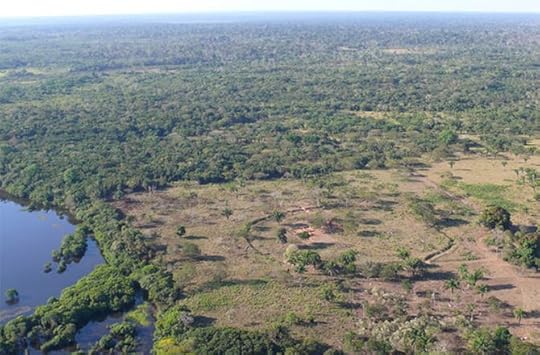 Shown here, a ring ditch next to Laguna Granja in the Amazon of northeastern Bolivia. A series of square, straight and ringlike ditches scattered throughout the Bolivian and Brazilian Amazon were there before the rainforest existed, a new study finds. These human-made structures remain a mystery: They may have been used for defense, drainage, or perhaps ceremonial or religious reasons. But the new research addresses another burning question: whether and how much prehistoric people altered the landscape in the Amazon before the arrival of Europeans "People have been affecting the global climate system through land use for not just the past 200 to 300 years, but for thousands of years," said study author John Francis Carson, a postdoctoral researcher at the University of Reading in the United Kingdom. For many years, archaeologists thought that the indigenous people who lived in the Amazon before Christopher Columbus arrived in the Americas in 1492 moved across the area while making barely a dent in the landscape. Since the 1980s, however, deforestation has revealed massive earthworks in the form of ditches up to 16 feet (5 meters) deep, and often just as wide.
Shown here, a ring ditch next to Laguna Granja in the Amazon of northeastern Bolivia. A series of square, straight and ringlike ditches scattered throughout the Bolivian and Brazilian Amazon were there before the rainforest existed, a new study finds. These human-made structures remain a mystery: They may have been used for defense, drainage, or perhaps ceremonial or religious reasons. But the new research addresses another burning question: whether and how much prehistoric people altered the landscape in the Amazon before the arrival of Europeans "People have been affecting the global climate system through land use for not just the past 200 to 300 years, but for thousands of years," said study author John Francis Carson, a postdoctoral researcher at the University of Reading in the United Kingdom. For many years, archaeologists thought that the indigenous people who lived in the Amazon before Christopher Columbus arrived in the Americas in 1492 moved across the area while making barely a dent in the landscape. Since the 1980s, however, deforestation has revealed massive earthworks in the form of ditches up to 16 feet (5 meters) deep, and often just as wide.
These discoveries have caused a controversy between those who believe Amazonians were still mostly gentle on the landscape, altering very little of the rainforest, and those who believe these pre-Columbian people conducted major slash-and-burn operations, which were later swallowed by the forest after the European invasion caused the population to collapse.
Carson and his colleagues wanted to explore the question of whether early Amazonians had a major impact on the forest. They focused on the Amazon of northeastern Bolivia, where they had sediment cores from two lakes nearby major earthworks sites. These sediment cores hold ancient pollen grains and charcoal from long-ago fires, and can hint at the climate and ecosystem that existed when the sediment was laid down as far back as 6,000 years ago.
An examination of the two cores — one from the large lake, Laguna Oricore, and one from the smaller lake, Laguna Granja — revealed a surprise: The very oldest sediments didn't come from a rainforest ecosystem at all. In fact, the Bolivian Amazon before about 2,000 to 3,000 years ago looked more like the savannas of Africa than today's jungle environment.
The question had been whether the early Amazon was highly deforested or barely touched, Carson said.
"The surprising thing we found was that it was neither," he told Live Science. "It was this third scenario where, when people first arrived on the landscape, the climate was drier."
http://news.discovery.com/history/archaeology/mysterious-earthen-rings-predate-amazon-rainforest-140707.htm

 Shown here, a ring ditch next to Laguna Granja in the Amazon of northeastern Bolivia. A series of square, straight and ringlike ditches scattered throughout the Bolivian and Brazilian Amazon were there before the rainforest existed, a new study finds. These human-made structures remain a mystery: They may have been used for defense, drainage, or perhaps ceremonial or religious reasons. But the new research addresses another burning question: whether and how much prehistoric people altered the landscape in the Amazon before the arrival of Europeans "People have been affecting the global climate system through land use for not just the past 200 to 300 years, but for thousands of years," said study author John Francis Carson, a postdoctoral researcher at the University of Reading in the United Kingdom. For many years, archaeologists thought that the indigenous people who lived in the Amazon before Christopher Columbus arrived in the Americas in 1492 moved across the area while making barely a dent in the landscape. Since the 1980s, however, deforestation has revealed massive earthworks in the form of ditches up to 16 feet (5 meters) deep, and often just as wide.
Shown here, a ring ditch next to Laguna Granja in the Amazon of northeastern Bolivia. A series of square, straight and ringlike ditches scattered throughout the Bolivian and Brazilian Amazon were there before the rainforest existed, a new study finds. These human-made structures remain a mystery: They may have been used for defense, drainage, or perhaps ceremonial or religious reasons. But the new research addresses another burning question: whether and how much prehistoric people altered the landscape in the Amazon before the arrival of Europeans "People have been affecting the global climate system through land use for not just the past 200 to 300 years, but for thousands of years," said study author John Francis Carson, a postdoctoral researcher at the University of Reading in the United Kingdom. For many years, archaeologists thought that the indigenous people who lived in the Amazon before Christopher Columbus arrived in the Americas in 1492 moved across the area while making barely a dent in the landscape. Since the 1980s, however, deforestation has revealed massive earthworks in the form of ditches up to 16 feet (5 meters) deep, and often just as wide.These discoveries have caused a controversy between those who believe Amazonians were still mostly gentle on the landscape, altering very little of the rainforest, and those who believe these pre-Columbian people conducted major slash-and-burn operations, which were later swallowed by the forest after the European invasion caused the population to collapse.
Carson and his colleagues wanted to explore the question of whether early Amazonians had a major impact on the forest. They focused on the Amazon of northeastern Bolivia, where they had sediment cores from two lakes nearby major earthworks sites. These sediment cores hold ancient pollen grains and charcoal from long-ago fires, and can hint at the climate and ecosystem that existed when the sediment was laid down as far back as 6,000 years ago.
An examination of the two cores — one from the large lake, Laguna Oricore, and one from the smaller lake, Laguna Granja — revealed a surprise: The very oldest sediments didn't come from a rainforest ecosystem at all. In fact, the Bolivian Amazon before about 2,000 to 3,000 years ago looked more like the savannas of Africa than today's jungle environment.
The question had been whether the early Amazon was highly deforested or barely touched, Carson said.
"The surprising thing we found was that it was neither," he told Live Science. "It was this third scenario where, when people first arrived on the landscape, the climate was drier."
http://news.discovery.com/history/archaeology/mysterious-earthen-rings-predate-amazon-rainforest-140707.htm

Published on July 08, 2014 12:45
2,500-year-old erotic graffiti found in unlikely setting on Aegean island
Racy inscriptions and phalluses carved into Astypalaia's rocky peninsula shed light on very private lives of ancient Greece
Helena Smith
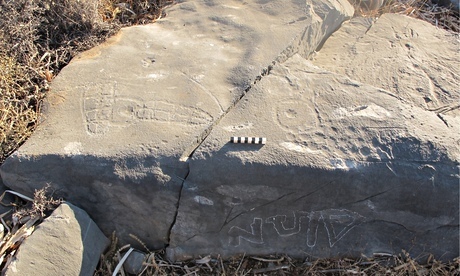
The erotic graffiti on Astypalaia also highlighted the extent of literacy at a time when the Acropolis in Athens had yet to be built. Photograph: Helena SmithWild, windswept, rocky and remote, Astypalaia is not an obvious place for the unearthing of some of the world's earliest erotic graffiti.
Certainly, Dr Andreas Vlachopoulos, a specialist in prehistoric archaeology, didn't think so when he began fieldwork on the Aegean island four years ago. Until he chanced upon a couple of racy inscriptions and large phalluses carved into Astypalaia's rocky peninsula at Vathy. The inscriptions, both dating to the fifth and sixth centuries BC, were "so monumental in scale" – and so tantalisingly clear – he was left in no doubt of the motivation behind the artworks.
"They were what I would call triumphant inscriptions," said the Princeton-trained professor who found them while introducing students to the ancient island world of the Aegean. "They claimed their own space in large letters that not only expressed sexual desire but talked about the act of sex itself," he told the Guardian. "And that is very, very rare."
Chiselled into the outcrops of dolomite limestone that dot the cape, the inscriptions have provided invaluable insight into the private lives of those who inhabited archaic and classical Greece. One, believed to have been carved in the mid-sixth century BC, proclaimed: "Nikasitimos was here mounting Timiona (Νικασίτιμος οἶφε Τιμίονα).
"We know that in ancient Greece sexual desire between men was not a taboo," added Dr Vlachopoulos, who returned to the far-flung island last week to resume work with a team of topographers, photographers, conservationists and students. "But this graffiti … is not just among the earliest ever discovered. By using the verb in the past continuous [tense], it clearly says that these two men were making love over a long period of time, emphasising the sexual act in a way that is highly unusual in erotic artwork. "
Found at the highest point of the promontory overlooking the Bay of Vathy on the island's north-western tip, the inscription has led the archaeologist to believe that soldiers may once have been garrisoned there.
Two penises engraved into limestone beneath the name of Dion, and dating to the fifth century BC, were also discovered at lower heights of the cape. "They would seem to allude to similar behaviour on the part of Dion," said Vlachopoulos.
The epigrapher, Angelos Matthaiou, said the graffiti had not only shed light on the very personal lives of the ancients but highlighted the extent of literacy at a time when the Acropolis in Athens had yet to be built. "Whoever wrote the erotic inscription referring to Timiona was very well trained in writing," said Matthaiou, for more than 25 years the general secretary at the Greek Epigraphic Society. "The letters have been very skillfully inscribed on the face of the rock, evidence that it was not just philosophers, scholars and historians who were trained in the art of writing but ordinary people living on islands too."
Other rock art found at the site include carvings depicting oared ships, daggers and spirals – all still discernible despite exposure to the erosive effects of wind and sea.
As the best-known motif of early Cycladic art representing the waves of the sea, spirals symbolised perpetual motion as the driving force in the life and thought of island communities.
"We know that Greek islands were inhabited by the third millienium BC., but what we have found is evidence that, even then, people were using a coded language of symbols and imagery that was quite sophisticated," said Dr Vlachopoulos.
Unit recently, Astypalaia has been better known for its ancient cemeteries of mass graves containing the remains of newborn infants. Now erotica has to be added to that sorry tale.
"Few Greek islands have been properly explored or excavated and these findings are testimony to why it is so important that they are," said the archaeologist.
• This article was amended on 8 July 2014. The headline claimed it was the world's oldest erotic graffiti. As stated in the article, it is only some of the world's oldest such artwork. This has been corrected.
http://www.theguardian.com/science/2014/jul/06/worlds-earliest-erotic-graffiti-astypalaia-classical-greece
http://www.theguardian.com/science/20...
Helena Smith

The erotic graffiti on Astypalaia also highlighted the extent of literacy at a time when the Acropolis in Athens had yet to be built. Photograph: Helena SmithWild, windswept, rocky and remote, Astypalaia is not an obvious place for the unearthing of some of the world's earliest erotic graffiti.
Certainly, Dr Andreas Vlachopoulos, a specialist in prehistoric archaeology, didn't think so when he began fieldwork on the Aegean island four years ago. Until he chanced upon a couple of racy inscriptions and large phalluses carved into Astypalaia's rocky peninsula at Vathy. The inscriptions, both dating to the fifth and sixth centuries BC, were "so monumental in scale" – and so tantalisingly clear – he was left in no doubt of the motivation behind the artworks.
"They were what I would call triumphant inscriptions," said the Princeton-trained professor who found them while introducing students to the ancient island world of the Aegean. "They claimed their own space in large letters that not only expressed sexual desire but talked about the act of sex itself," he told the Guardian. "And that is very, very rare."
Chiselled into the outcrops of dolomite limestone that dot the cape, the inscriptions have provided invaluable insight into the private lives of those who inhabited archaic and classical Greece. One, believed to have been carved in the mid-sixth century BC, proclaimed: "Nikasitimos was here mounting Timiona (Νικασίτιμος οἶφε Τιμίονα).
"We know that in ancient Greece sexual desire between men was not a taboo," added Dr Vlachopoulos, who returned to the far-flung island last week to resume work with a team of topographers, photographers, conservationists and students. "But this graffiti … is not just among the earliest ever discovered. By using the verb in the past continuous [tense], it clearly says that these two men were making love over a long period of time, emphasising the sexual act in a way that is highly unusual in erotic artwork. "
Found at the highest point of the promontory overlooking the Bay of Vathy on the island's north-western tip, the inscription has led the archaeologist to believe that soldiers may once have been garrisoned there.
Two penises engraved into limestone beneath the name of Dion, and dating to the fifth century BC, were also discovered at lower heights of the cape. "They would seem to allude to similar behaviour on the part of Dion," said Vlachopoulos.
The epigrapher, Angelos Matthaiou, said the graffiti had not only shed light on the very personal lives of the ancients but highlighted the extent of literacy at a time when the Acropolis in Athens had yet to be built. "Whoever wrote the erotic inscription referring to Timiona was very well trained in writing," said Matthaiou, for more than 25 years the general secretary at the Greek Epigraphic Society. "The letters have been very skillfully inscribed on the face of the rock, evidence that it was not just philosophers, scholars and historians who were trained in the art of writing but ordinary people living on islands too."
Other rock art found at the site include carvings depicting oared ships, daggers and spirals – all still discernible despite exposure to the erosive effects of wind and sea.
As the best-known motif of early Cycladic art representing the waves of the sea, spirals symbolised perpetual motion as the driving force in the life and thought of island communities.
"We know that Greek islands were inhabited by the third millienium BC., but what we have found is evidence that, even then, people were using a coded language of symbols and imagery that was quite sophisticated," said Dr Vlachopoulos.
Unit recently, Astypalaia has been better known for its ancient cemeteries of mass graves containing the remains of newborn infants. Now erotica has to be added to that sorry tale.
"Few Greek islands have been properly explored or excavated and these findings are testimony to why it is so important that they are," said the archaeologist.
• This article was amended on 8 July 2014. The headline claimed it was the world's oldest erotic graffiti. As stated in the article, it is only some of the world's oldest such artwork. This has been corrected.
http://www.theguardian.com/science/2014/jul/06/worlds-earliest-erotic-graffiti-astypalaia-classical-greece
http://www.theguardian.com/science/20...
Published on July 08, 2014 12:37
The Briton and the Dane: Concordia featured on Booktrack

Read an excerpt accompanied to music
Note: The site can only be accessed using Chrome as your browser.
Enjoyed reading The Briton and the Dane: Concordia with @Booktrack http://studio.booktrack.com/booktrack...

Published on July 08, 2014 03:15
History Trivia - city of Paris, France was founded by the Parisii
July 8
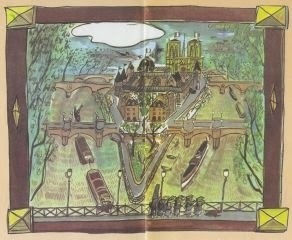
49 BC, the city of Paris, France was founded by the Parisii, a Celtic tribe of fishermen.

810 Pepin, son of Charlemagne, King of Italy, died.
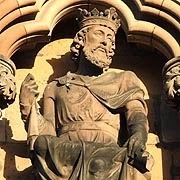
975 Edgar, considered the first King of a united England, reigning over Mercia, Northumbria and Wessex, died.

1099 First Crusade: 15,000 starving Christian soldiers marched in a religious procession around Jerusalem as its Muslim defenders watched. The Crusaders were ultimately victorious in taking the city.

1249 Alexander II, King of Scotland died.


49 BC, the city of Paris, France was founded by the Parisii, a Celtic tribe of fishermen.

810 Pepin, son of Charlemagne, King of Italy, died.

975 Edgar, considered the first King of a united England, reigning over Mercia, Northumbria and Wessex, died.

1099 First Crusade: 15,000 starving Christian soldiers marched in a religious procession around Jerusalem as its Muslim defenders watched. The Crusaders were ultimately victorious in taking the city.

1249 Alexander II, King of Scotland died.

Published on July 08, 2014 03:14
July 7, 2014
The Briton and the Dane: Timeline featured on Booktrack
Read an excerpt accompanied to music

Note: The site can only be accessed using Chrome as your browser.
Enjoyed reading The Briton and the Dane: Timeline with @Booktrack http://studio.booktrack.com/booktrack=016a00bbca2844cc96cb03a0c0bb717e


Note: The site can only be accessed using Chrome as your browser.
Enjoyed reading The Briton and the Dane: Timeline with @Booktrack http://studio.booktrack.com/booktrack=016a00bbca2844cc96cb03a0c0bb717e

Published on July 07, 2014 08:42
History Trivia - Julius Caesar's second invasion Britain begins
July 7

54 BC Julius Caesar's second invasion Britain begins as he lands his troops, probably near Deal, Kent.

1124 Tyre (city in Lebanon) surrendered to the Crusaders.

1307 King Edward I of England died at age 68 on his way to subdue the new Scottish king, Robert Bruce.

1456 A retrial verdict acquitted Joan of Arc of heresy 25 years after her death.

1550 Chocolate was introduced.
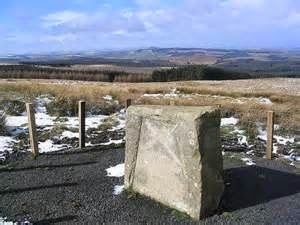
1575 Raid of the Redeswire, the last major battle between England and Scotland. The Scots proved victorious. The story of the skirmish was turned into a Border ballad.

1607 “God Save the King" was sung for the first time.


54 BC Julius Caesar's second invasion Britain begins as he lands his troops, probably near Deal, Kent.

1124 Tyre (city in Lebanon) surrendered to the Crusaders.

1307 King Edward I of England died at age 68 on his way to subdue the new Scottish king, Robert Bruce.

1456 A retrial verdict acquitted Joan of Arc of heresy 25 years after her death.

1550 Chocolate was introduced.

1575 Raid of the Redeswire, the last major battle between England and Scotland. The Scots proved victorious. The story of the skirmish was turned into a Border ballad.

1607 “God Save the King" was sung for the first time.

Published on July 07, 2014 06:24



